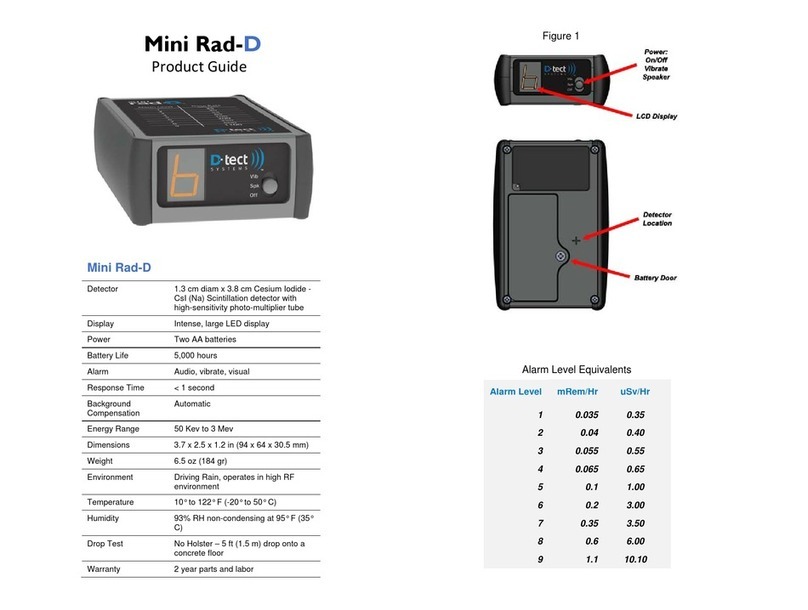INTRODUCTION
A CCTV event trigger utilising two independent passive
infrared detectors combined in a T05 package and a
microwave sensor. Both PIR sensors and the microwave
have to trigger before the detector signals an alarm. The
high precision, very reliable presence detector has been
designed for use within CCTV installations and will alarm if
tampered by masking.
The integral dual axis tilt sensor allows 180° of pan
and 90° tilt. This increases the speed of the outdoor
installation and provides incredibly accurate aiming of
the detection pattern. The electronics module is acrylic
coated for additional component stability. It is encased in
a vandal-resistant high impact zinc alloy housing with a
UV stabilised translucent front cover ensuring the sensor
is impervious to and unaffected by weather conditions.
Additionally the combination of precision electronics,
digital white light lter and double shielding eliminates
false alarms from the sun and other visible light sources.
The DUAL TECH AM design gives a neat and
professional appearance with no visible indication of the
orientation of the detector head, and totally hides the
wiring.
QUICK INSTALLATION GUIDE
Apply supply voltage to the unit, the amber led ashes 10
times, then the blue LED ashes 3 times.
The detector takes approximately 2-3 minutes to settle.
The walk test led is factory set to OFF. Pressing the
program button once will enable the walk test LED for 5
minutes.
THE FRONT COVER MUST BE FITTED WHEN WALK
TESTING
FACTORY SETTINGS ARE:
1 RANGE 30 METRES
2 PULSE COUNT 1
3 LED OFF
When enabled the D-TECT DUAL TECH AM has four LED
indicators.
Green - Microwave detection
Red - Both PIRs detection
Blue - Alarm output, both PIRs and microwave detection
Amber - Anti-Mask detection
ANTI-MASKING CIRCUIT
The cover must be tted before applying power to the
detector.
During the rst 10 seconds after power has been
connected, the amber LED ashes and the anti-masking
circuit starts to self calibrate. The amber LED indicates
when the detector is covered, but the relay contacts do not
operate until the unit has been covered for 60 seconds.
SEQUENCE FOR CORRECT OPERATION
1. Make connection and replace cover.
2. Apply 12 volts power. Amber LED Flashes 10 times -
self calibration completed.
3. Cover detector for 60 seconds. When anti-mask
detection is continuous for 60 seconds the normally closed
relay will open until anti-mask detection is cleared.
STAGE 1 - Mounting the unit
- During installation the electronics must be protected
against water, as trapped moisture can affect or damage
the unit.
1. Using the template provided drill the wall to accept the
two xing screws, the cable entry and the tamper cup (if
used). See g 1 and 2.
Note: We recommend using the tamper cup on uneven
wall surfaces.
2. Remove the cover assembly by loosening the locking
screw. The cover hinges from the top and lifts out of the
location slot. See g 3.
3. Feed standard 8 core alarm cable into the cable entry;
bare the wires and connect to the terminal block as shown
in g 7. Screw the unit to the wall ensuring that the tamper
pin is correctly located and that the tamper microswitch
is closed. See g 4 and 5. To aid installation, two spare
tamper feet are provided. One is 1mm longer and the
other is 2mm longer than the tamper foot originally tted.
The tamper foot is a push t and can be removed by
carefully pulling it from the pin. See g 2.
4. Always ensure when replacing the electronics module
that the LED is facing forward so as to ensure correct
alignment of the beam pattern. (Refer section titled
“Multibeam Alignment & Masking”).
5. When the detector has been aligned to suit the
installation,replace the front cover and lock as shown. See
g 6.
D-TECT Dual Tech
GJD360/AM Movement Detector



























